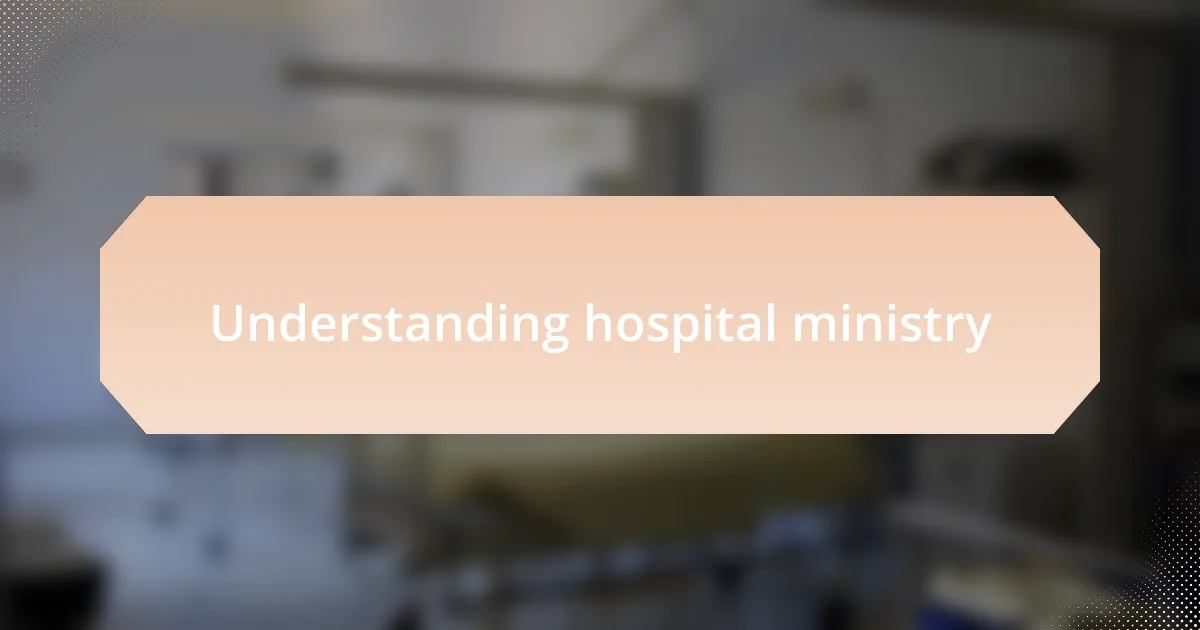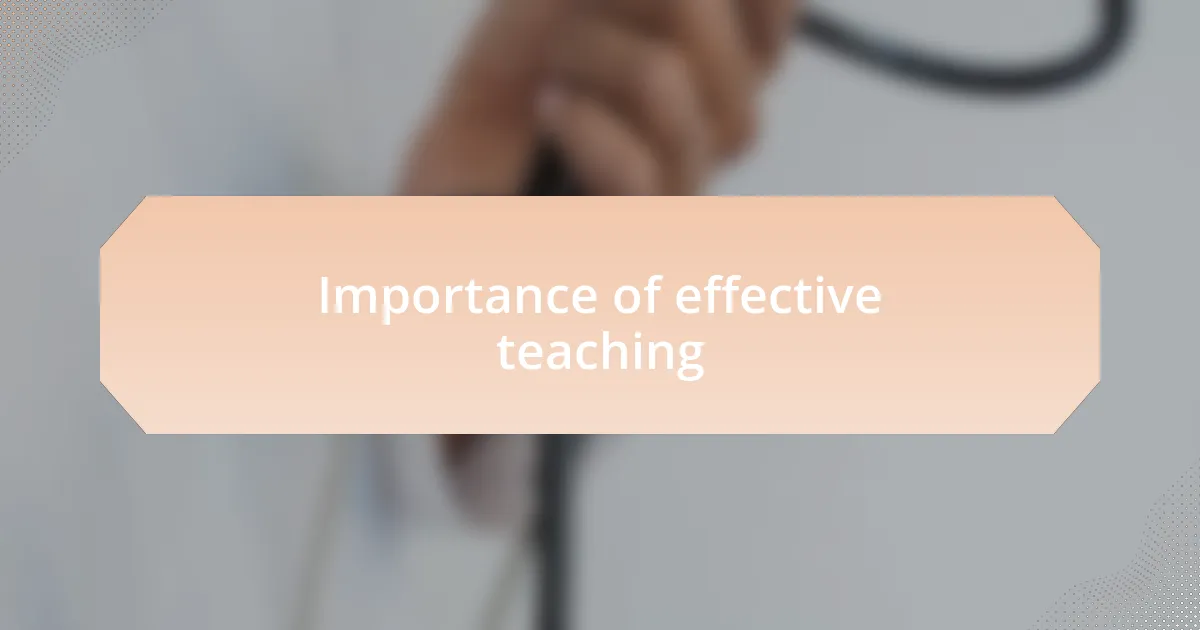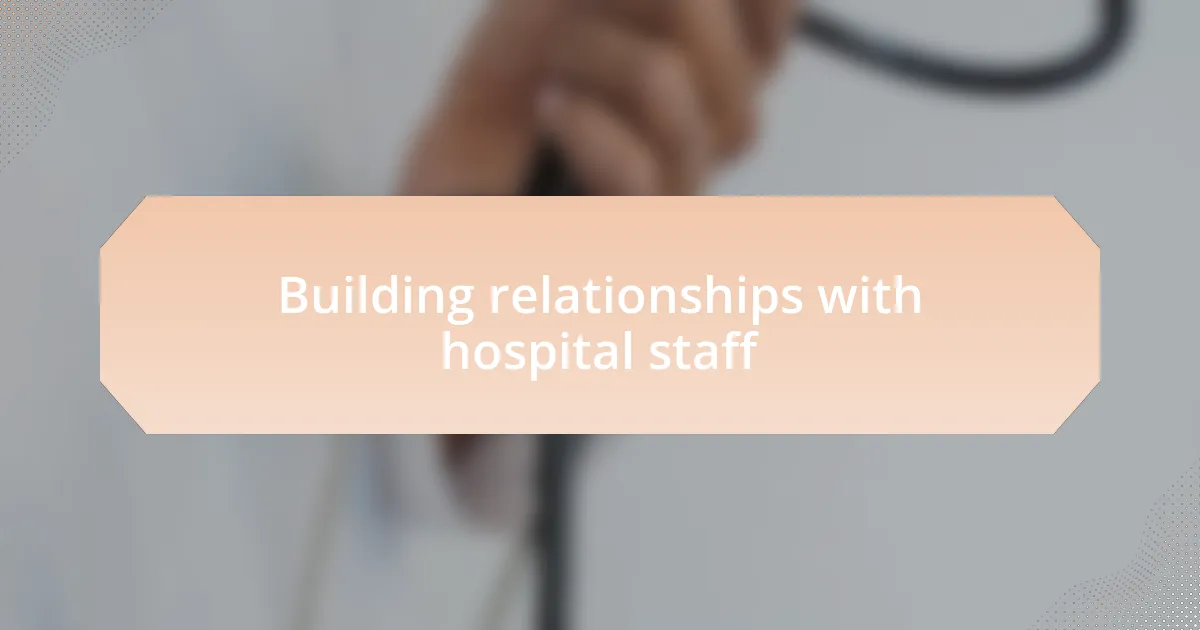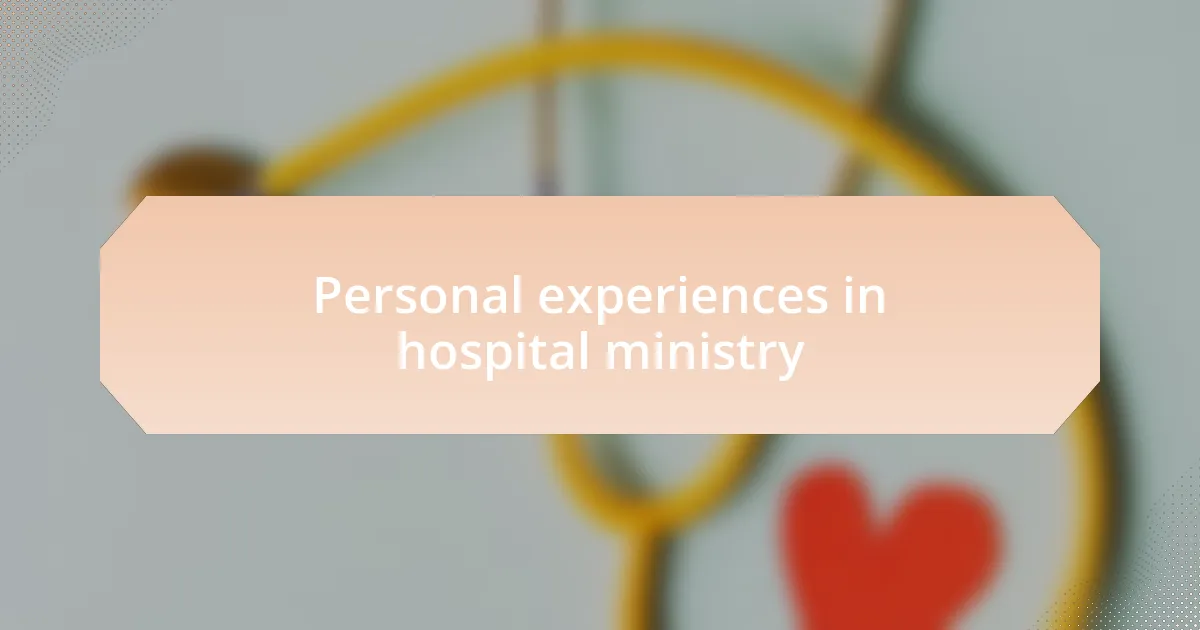Key takeaways:
- Hospital ministry focuses on providing spiritual support, emphasizing the importance of presence and listening in the healing process.
- Effective teaching, characterized by active listening and adaptability, enhances interactions between volunteers and patients, fostering a compassionate care environment.
- Engagement strategies such as storytelling, visual aids, and patient preference discussions significantly increase patient involvement in their care.
- Building relationships with hospital staff leads to improved collaboration, trust, and ultimately better patient care experiences.

Understanding hospital ministry
Hospital ministry is a unique and vital aspect of healthcare, focusing on providing spiritual support to patients, their families, and healthcare staff. When I first walked into a hospital room, the sterile environment struck me—not just because of the equipment, but because of the palpable vulnerability of the patients. Have you ever considered how a simple prayer or kind conversation can shift the atmosphere in such a place?
In my experience, every interaction within the walls of a hospital is an opportunity for ministry. I recall a specific patient who, through her tearful story, opened my eyes to the power of listening. It wasn’t just about offering solutions; it was about offering presence. How often do we underestimate the strength of simply being there for someone in their darkest hour?
Moreover, understanding hospital ministry involves recognizing the emotional and spiritual dimensions of health and healing. I’ve seen how sharing faith can uplift patients, helping them feel less isolated. When we touch hearts, we forge connections that can bring hope and light in the most challenging times.

Importance of effective teaching
Effective teaching in the context of hospital ministry plays a crucial role in transforming the way we engage with patients and their families. I remember one instance when I facilitated a workshop for volunteers. During this workshop, I emphasized the importance of active listening and empathy. It was incredible to witness how this simple shift in approach not only enriched the volunteers’ interactions but also significantly enhanced the patients’ sense of being heard and understood.
At times, I’ve found myself reflecting on how effective teaching can create a ripple effect. When volunteers learn to approach each situation with care and intention, the impact extends far beyond the hospital walls. Have you ever seen a patient light up after a heartfelt conversation? Those moments remind me that teaching isn’t just about imparting knowledge; it’s about nurturing a compassionate mindset that can foster healing.
Furthermore, the importance of effective teaching lies in its ability to equip caregivers with the skills they need to provide holistic support. I recall attending a seminar where we delved into communication techniques. The insights I gained not only changed how I interacted with patients but also inspired others to adopt a more thoughtful approach to their compassionate care. It’s a powerful reminder that our teaching can profoundly shape the atmosphere of healing and hope within a hospital setting.

Core principles of effective teaching
One of the core principles of effective teaching is the creation of a supportive learning environment. I’ve experienced how vital it is to foster a space where individuals feel safe to express their thoughts and questions. When I first started teaching volunteers, I noticed that encouraging an open dialogue not only boosted their confidence but led to deeper, more meaningful exchanges with patients. Have you ever sensed a shift in energy when a learner felt validated? It’s remarkable how that change can enhance the entire learning experience.
Another fundamental principle is the importance of adaptability. I recall a training session where I had to shift my approach mid-way because the group was struggling with the material. By adjusting my teaching style to meet their needs, I witnessed a transformation. It felt rewarding to see them engage and grasp concepts that seemed challenging just moments before. This adaptability isn’t just practical; it’s a reflection of our commitment to the ongoing journey of learning, both for ourselves and those we teach.
Engagement is also crucial in the teaching process. I remember incorporating role-playing activities into our sessions, allowing volunteers to practice real-life scenarios. The energy in the room shifted as participants laughed, learned, and truly connected with the material. It hit me that when teaching becomes interactive, it not only retains attention but also builds essential skills. How often do we underestimate the power of active participation? By embracing this principle, we cultivate a dynamic atmosphere where learning and compassion thrive together.

Strategies for engaging patients
One effective strategy for engaging patients is to incorporate storytelling into our interactions. I recall a time when I shared a personal story about overcoming a health challenge during a conversation with a patient. The patient not only opened up about their own experiences but also began to smile and share their hopes. It felt like that shared vulnerability created an invisible thread connecting us, fostering a deeper relationship and encouraging them to participate more actively in their own care discussions.
Another valuable approach is to use visual aids or props during educational sessions. I once brought in a model of the human heart, and the patients were instantly intrigued. As we explored the model together, I noticed their curiosity sparked questions that led to insightful conversations. Have you ever seen how a tangible item can shift focus and break down barriers? It can profoundly enhance understanding and engagement.
Lastly, providing opportunities for patients to express their preferences regarding their care can significantly increase their involvement. I always make it a point to ask patients what they feel comfortable with during our discussions. This simple question has often led to enlightening conversations about their values and priorities in treatment. It’s fascinating how when patients feel heard, their enthusiasm for participating in their own journey often flourishes.

Building relationships with hospital staff
Building strong relationships with hospital staff is crucial for creating a supportive environment. I remember my first day on the ward—nerves were high, and I felt like an outsider. However, taking the initiative to introduce myself to nurses and doctors helped break down barriers. Wouldn’t you agree that a simple greeting can lead to more meaningful interactions?
Engaging with staff during their shifts not only builds trust but also fosters collaboration. I once joined a group of nurses during their break. We shared laughs and discussed the challenges of our roles. That camaraderie made me feel like part of the team, and it encouraged open communication when it came to patient care. Isn’t it amazing how relationships can grow in the simplest of settings?
One of the most rewarding aspects of connecting with hospital staff is seeing the positive impact on patient care. I remember collaborating with a case manager on a particularly challenging patient case. Our brainstorming session led to innovative solutions that improved the patient’s experience. When support staff feels valued and understood, their enthusiasm often reflects in their interactions with patients. How beautiful is it to witness that synergy in action?

Personal experiences in hospital ministry
During my time in hospital ministry, I’ve encountered countless moments that have shaped my understanding of compassion. One particular instance still resonates with me; a patient, visibly anxious, shared her fear of surgery. I sat with her to listen, holding her hand and providing reassurance. It struck me how powerful just being present can be. Isn’t it remarkable how sincerity transforms not just the recipient but the giver too?
While I have had many emotional exchanges, one of the most profound came when I visited a terminally ill patient. As we talked about her life, laughter erupted despite the circumstances. I remember sharing stories about her favorite books, and her eyes sparkled with nostalgia. It made me realize that joy can coexist with sorrow. How can mere words have such a profound effect on someone’s spirit?
Reflections on my journey often lead me to the smallest gestures that create the biggest differences. I recall bringing homemade cookies to share with patients and staff alike. That simple act ignited smiles and spontaneous conversations, reminding me that even the smallest kindness can uplift weary hearts. How often do we underestimate the power of a tiny gesture in healing?

Reflections on teaching success
Reflections on teaching success often take me back to moments when insightful discussions sparked lightbulb moments for my students. I once hosted a small group discussion on coping mechanisms after loss, where one student’s heartfelt sharing led others to open up about their struggles as well. In that moment, I felt the incredible weight of community and connection in the room. Isn’t it amazing how sharing vulnerabilities can turn into a powerful tool for growth?
I’ve also learned that feedback is a vital aspect of effective teaching. There was a time when I implemented a peer assessment activity, allowing students to evaluate each other’s presentations. Initially, I was hesitant about their ability to provide constructive criticism, but the results surprised me. The insights shared not only elevated their understanding but also fostered a new level of collaboration. Could this be the secret ingredient to deepening their learning experience?
In every successful teaching experience I’ve had, the joy of witnessing growth stands out. I remember a shy student transforming into a confident speaker after several sessions focused on building their public speaking skills. The moment they confidently delivered a presentation, beaming with pride, was unforgettable. Reflecting on that experience, I ask myself—what other hidden potentials lie within our students, waiting to be discovered and nurtured?